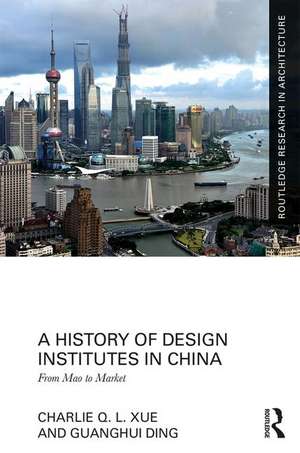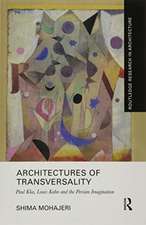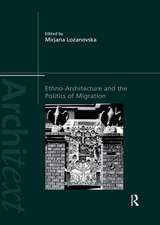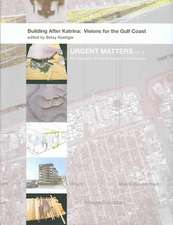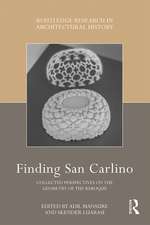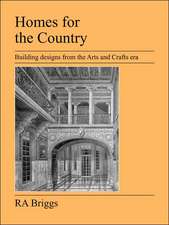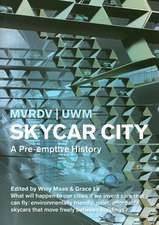A History of Design Institutes in China: From Mao to Market: Routledge Research in Architecture
Autor Charlie Q. L. Xue, Guanghui Dingen Limba Engleză Hardback – 2 aug 2018
Appealing to academics, researchers, and graduate students, this book provides a much-needed contribution to the discourse on architectural history, building practices, and policymaking in contemporary China.
| Toate formatele și edițiile | Preț | Express |
|---|---|---|
| Paperback (1) | 259.62 lei 6-8 săpt. | |
| Taylor & Francis – 23 mar 2020 | 259.62 lei 6-8 săpt. | |
| Hardback (1) | 765.84 lei 6-8 săpt. | |
| Taylor & Francis – 2 aug 2018 | 765.84 lei 6-8 săpt. |
Din seria Routledge Research in Architecture
- 9%
 Preț: 1004.48 lei
Preț: 1004.48 lei -
 Preț: 312.22 lei
Preț: 312.22 lei - 9%
 Preț: 866.91 lei
Preț: 866.91 lei -
 Preț: 351.26 lei
Preț: 351.26 lei -
 Preț: 312.44 lei
Preț: 312.44 lei -
 Preț: 311.48 lei
Preț: 311.48 lei -
 Preț: 310.45 lei
Preț: 310.45 lei -
 Preț: 307.47 lei
Preț: 307.47 lei - 9%
 Preț: 866.04 lei
Preț: 866.04 lei - 9%
 Preț: 936.16 lei
Preț: 936.16 lei - 26%
 Preț: 766.24 lei
Preț: 766.24 lei - 26%
 Preț: 766.24 lei
Preț: 766.24 lei -
 Preț: 449.41 lei
Preț: 449.41 lei -
 Preț: 449.41 lei
Preț: 449.41 lei - 12%
 Preț: 299.52 lei
Preț: 299.52 lei - 25%
 Preț: 767.07 lei
Preț: 767.07 lei -
 Preț: 449.41 lei
Preț: 449.41 lei -
 Preț: 489.26 lei
Preț: 489.26 lei - 18%
 Preț: 1003.43 lei
Preț: 1003.43 lei -
 Preț: 442.68 lei
Preț: 442.68 lei -
 Preț: 449.41 lei
Preț: 449.41 lei - 18%
 Preț: 1109.99 lei
Preț: 1109.99 lei - 26%
 Preț: 765.84 lei
Preț: 765.84 lei - 26%
 Preț: 849.37 lei
Preț: 849.37 lei -
 Preț: 489.26 lei
Preț: 489.26 lei - 18%
 Preț: 998.71 lei
Preț: 998.71 lei - 18%
 Preț: 1054.71 lei
Preț: 1054.71 lei -
 Preț: 443.65 lei
Preț: 443.65 lei - 18%
 Preț: 1001.07 lei
Preț: 1001.07 lei - 26%
 Preț: 766.24 lei
Preț: 766.24 lei - 22%
 Preț: 324.16 lei
Preț: 324.16 lei - 26%
 Preț: 766.24 lei
Preț: 766.24 lei - 25%
 Preț: 718.39 lei
Preț: 718.39 lei - 26%
 Preț: 765.01 lei
Preț: 765.01 lei - 18%
 Preț: 1057.75 lei
Preț: 1057.75 lei - 26%
 Preț: 850.17 lei
Preț: 850.17 lei -
 Preț: 449.41 lei
Preț: 449.41 lei - 25%
 Preț: 716.13 lei
Preț: 716.13 lei - 13%
 Preț: 338.33 lei
Preț: 338.33 lei - 18%
 Preț: 1165.20 lei
Preț: 1165.20 lei
Preț: 765.84 lei
Preț vechi: 1028.36 lei
-26% Nou
Puncte Express: 1149
Preț estimativ în valută:
146.57€ • 151.72$ • 123.88£
146.57€ • 151.72$ • 123.88£
Carte tipărită la comandă
Livrare economică 06-20 martie
Preluare comenzi: 021 569.72.76
Specificații
ISBN-13: 9781138562332
ISBN-10: 1138562335
Pagini: 242
Ilustrații: 5 Line drawings, black and white; 36 Halftones, black and white; 41 Illustrations, black and white
Dimensiuni: 156 x 234 x 18 mm
Greutate: 0.54 kg
Ediția:1
Editura: Taylor & Francis
Colecția Routledge
Seria Routledge Research in Architecture
Locul publicării:Oxford, United Kingdom
ISBN-10: 1138562335
Pagini: 242
Ilustrații: 5 Line drawings, black and white; 36 Halftones, black and white; 41 Illustrations, black and white
Dimensiuni: 156 x 234 x 18 mm
Greutate: 0.54 kg
Ediția:1
Editura: Taylor & Francis
Colecția Routledge
Seria Routledge Research in Architecture
Locul publicării:Oxford, United Kingdom
Public țintă
PostgraduateCuprins
1 Introduction Part I Engineering the Political Machine 2 The Emergence of State-owned Design Institutes 3 Socialist Construction during the Cold War: 1950-1965 Part II Surfing the Economic Wave 4 Returning to the Normal Track: 1972-1995 5 Reform and Transformation in the Twenty-first Century 6 State Missions in the Urban Expansion and Green Architecture Part III Enhancing the Cultural Power 7 Where Production, Teaching and Research Meet: University-run Design Institutes 8 Architectural Export from China’s Design Institutes 9 Conclusion
Notă biografică
Charlie Q. L. Xue has held teaching appointments in architecture at Jiaotong University, Shanghai; the University of Texas, USA; and City University of Hong Kong. He has published numerous books including Building a Revolution: Chinese Architecture since 1980, Hong Kong Architecture 1945-2015: from Colonial to Global and research papers in international refereed journals such as the Journal of Architecture, Urban Design International, Habitat International, and Cities. Xue’s research focuses on architecture in China and design strategies for high-density environments.
Guanghui Ding teaches architecture at Beijing University of Civil Engineering and Architecture, China. His book Constructing a Place of Critical Architecture in China was published by Routledge in 2016. His articles have been published by Architectural Research Quarterly, Habitat International, and Journal of the Society of Architectural Historians. Ding’s research focuses on the history, theory, and criticism of modern Chinese architecture. Based in Beijing, he practices architecture both independently and collaboratively.
Guanghui Ding teaches architecture at Beijing University of Civil Engineering and Architecture, China. His book Constructing a Place of Critical Architecture in China was published by Routledge in 2016. His articles have been published by Architectural Research Quarterly, Habitat International, and Journal of the Society of Architectural Historians. Ding’s research focuses on the history, theory, and criticism of modern Chinese architecture. Based in Beijing, he practices architecture both independently and collaboratively.
Recenzii
"This account of the history of design institutes in China from 1950 to 2015 fills an enormous gap in our previous knowledge of contemporary Chinese architecture. Charlie Xue and Guanghui Ding inform us through their prodigious study of the remarkable scope of the state-backed Chinese design institutes which first emerged with the foundation of the People's Republic of China in 1949. In recent years these design offices have transcended their initial rather bureaucratic character by being reorganized into semi-independent design studios led by talented architects such as Cui Kai and Li Xinggang of the China Design Group, or the architects of the He Jingtang studio of the South China Design Institute, these last being responsible for the expansion of the Nanjing Massacre memorial hall in 2008. The authors proceed to show how the prowess of these design institutes have been an integral part of the exportation of modern Chinese culture to developing countries, above all in Africa and South East Asia."
Kenneth Frampton, Columbia University, USA
"The explosion of scholarship about modern Chinese architecture over the past decade has been remarkable, and is set to expand further. Nonetheless, it has been hard to get a sense from the outside of the key role played by the state-run design institutes. Now, in this comprehensive and fascinating account by Charlie Xue and Guanghui Ding, we can read of their creation under 1950s Maoist Communism, their liberalisation after Deng Xiaoping's 'Open Door' policy, and the complex situation today of major design institutes being run by prestigious architectural schools like Tongji University and Tsinghua University, or of design-focussed 'boutique' practices flourishing under the umbrella of vast commercial institutes."
Murray Fraser, University College London, UK
Kenneth Frampton, Columbia University, USA
"The explosion of scholarship about modern Chinese architecture over the past decade has been remarkable, and is set to expand further. Nonetheless, it has been hard to get a sense from the outside of the key role played by the state-run design institutes. Now, in this comprehensive and fascinating account by Charlie Xue and Guanghui Ding, we can read of their creation under 1950s Maoist Communism, their liberalisation after Deng Xiaoping's 'Open Door' policy, and the complex situation today of major design institutes being run by prestigious architectural schools like Tongji University and Tsinghua University, or of design-focussed 'boutique' practices flourishing under the umbrella of vast commercial institutes."
Murray Fraser, University College London, UK
Descriere
This book examines the relationship between design institutes, the state and the market economy through a discussion of significant theoretical and historical issues.
